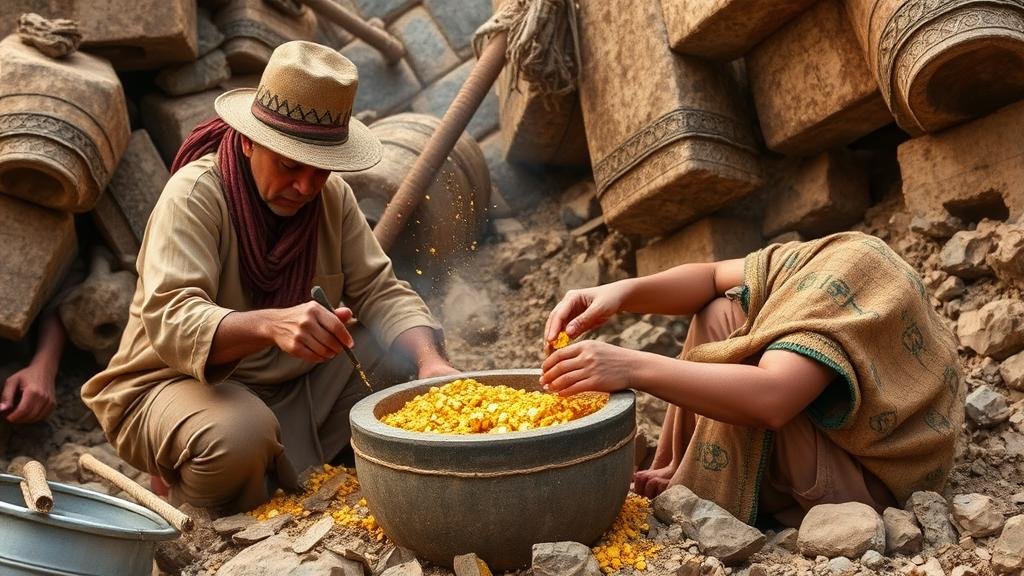Mining Techniques of the Inca: Extracting Gold in the Andes
Mining Techniques of the Inca: Extracting Gold in the Andes
The Inca Empire, which flourished in South America from the early 15th century until its conquest by Spanish forces in the 16th century, is renowned for its impressive architectural achievements, sophisticated agricultural techniques, and intricate social organization. Among these achievements, the mining and extraction of gold and other precious metals stands out as a hallmark of Inca technology and economy. This article explores the mining techniques used by the Inca, focusing particularly on gold extraction in the Andes region.
Historical Context of Inca Gold Mining
Gold held immense cultural and economic significance for the Inca people. It was not merely a form of currency or wealth; gold was considered the sweat of the sun and was used extensively in religious ceremonies and royal offerings. The region of the Andes, rich in mineral resources, became central to their mining activities. An estimated 65% of the worlds gold output in the 15th century originated from this region, underscoring the Incas prowess in mining.
Techniques of Gold Extraction
The Inca employed several sophisticated techniques for extracting gold from the rocky terrain of the Andes. r methods can be categorized into two primary approaches: surface mining and underground mining.
Surface Mining
Surface mining techniques were commonly used when gold deposits were located near the earths surface. This involved the following methods:
- Washing and Panning: The Incas utilized water to wash soil and gravel, allowing heavier gold particles to settle. This technique, known as panning, enabled them to extract alluvial gold without extensive excavation.
- Open-Pit Mining: Where gold veins were exposed, the Inca would excavate larger pits, removing overburden to access the mineral deposits. This method, while labor-intensive, was effective for surface-level deposits.
Underground Mining
For deeper gold deposits, the Incas employed more advanced underground mining techniques:
- Adits and Shafts: The Inca constructed horizontal tunnels (adits) and vertical shafts to reach gold deposits situated deep beneath the surface. This required significant engineering skill and knowledge of geology.
- Fire Setting: To break apart rock, the Incas used fire setting, a method which involved heating the rock with fires and then cooling it rapidly with water. This caused the rock to crack and facilitated easier extraction.
Tools and Technology
The Inca miners utilized a variety of tools designed for efficiency. Key among these were:
- Stone Tools: Chisels and hammers made of stone were employed to carve and break rock.
- Inca Mining Picks: These were crafted from harder materials such as bronze, enabling miners to penetrate deeper deposits more effectively.
To transport ore, they also developed a system of roads and trails accommodating the movement of materials across challenging Andean terrain.
Environmental Impact and Sustainability
While the Inca were adept at gold extraction, their techniques also had environmental consequences. Open-pit mining and the dismantling of rock layers disrupted ecosystems and altered landscapes. But, unlike many modern mining operations, the Incas practiced some level of sustainability, often using the land around mining sites for agriculture, which allowed them to maintain a balance between resource extraction and ecological health.
Real-World Applications and Legacy
The mining techniques developed by the Incas laid the groundwork for future mining operations in South America. Modern methods still often rely on principles first established by ancient civilizations. For example, the focus on sustainability and minimal environmental disruption can be traced back to Inca practices. Also, the use of water in gold extraction is a concept that persists in todays mining technology.
Conclusion
The Inca civilization was not only skilled in politics and architecture but also excelled in the sophisticated art of mining. r techniques for extracting gold from the Andes demonstrate an impressive blend of innovation, practical engineering, and respect for the environment. While the practices of the past may not align perfectly with contemporary standards of sustainability, they offer valuable insights into the responsible stewardship of natural resources.
As we continue to explore and develop mining technologies, we should look to the enduring legacy of the Inca as a model for balancing extraction with ecological integrity.


